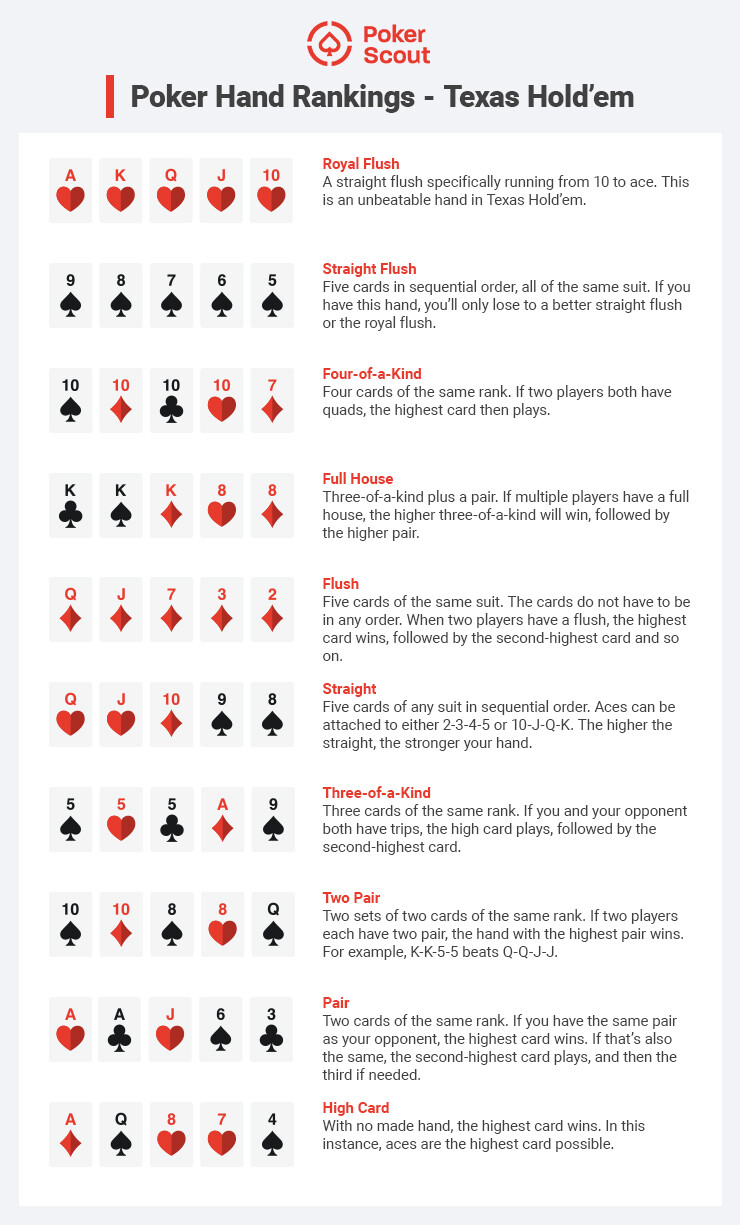Texas Hold’em is the world’s most popular version of poker. At first glance, the game seems simple, but learning how to play Texas Hold’em takes a good grasp of the rules, timing, and strategy.
Scratch beneath the surface, and you’ll discover that Texas Hold’em is an exciting game that involves bold moves and intricate strategy.
Read on for our complete guide to Texas Hold ’em rules, hands, and essential tips for beginners.
What is Texas Hold’em?
Texas Hold’em is a well-known community-card poker variant where players use two hole cards and five shared community cards, allowing players to make the best possible five-card hand. Each player can combine their hole cards with the community cards to create their hand.
Texas Hold’em originated in Robstown, Texas, and gained popularity throughout the state before being introduced to the gambling capital of Las Vegas in the 1960s.
After the World Series of Poker’s creation and later its rise on televised broadcasts, the game became cemented as the world’s number one poker variant. If you’re learning how to play poker, Texas Hold’em is one of the first games you’ll probably understand.
Texas Hold’em Poker: How to Play
Learning to play Texas Hold’em is quite simple. The objective is to win all of the poker chips that are available. There are two ways in which you can win these chips:
- By holding the best five-card hand when the time comes to show your cards;
- By forcing your opponents to fold before they’re permitted to show their cards.
As simple as it sounds, there are many ways to do this using different Texas Hold’em strategy options, with more advanced players dedicating hours to studying at the best poker training sites.
Now we know the objectives, we need to learn the ins and outs of Texas Hold’em poker rules.
Texas Hold’em Rules
Poker is a card game for 2 to 10 players at each table, using chips for betting and keeping score. Most poker hands, whether in tournaments, cash games, online, or in-person, start the same way. The player to the immediate left of the dealer pays a portion of their chips called a small blind, with the player immediately to their left paying a big blind, which is double in value to the small.
Blinds exist in poker tournaments to ensure that there is a cost for players to take part in the game. Without them, everyone would sit around all day waiting for A♣A♠.
Cards
First, each player receives two cards that only they can see. The dealer distributes cards from one deck (52 cards), face down, starting with the player in the small blind position and moving clockwise. Once everyone has received a card, the dealer deals a second card in the same way. These two hidden cards are known as hole cards.
After dealing the hole cards, the dealer then places up to five face-up community cards, which can be used by any player still in the hand.
Betting Structure
To learn how to play Texas Hold’em poker, you need to understand what the bet limits are for that game or tournament. There are typically four kinds of betting that take place in Texas Hold’em poker hands:
- Hold’em ‘limit’: Bets are capped in each round
- Hold’em ‘no limit’: Bets are uncapped – players can bet any amount
- Hold’em ‘pot limit’: The bet limit is the total of the pot
- Hold’em ‘mixed’: Limit and no-limit rounds alternate
No limit is by far the most widely used version of Texas Hold’em rules, but there are also plenty of limit options at the best online poker sites in the US.
All in
Going all in is a bold move where a player bets all of their remaining chips in a single hand. In Texas Hold’em, it can be a strong play when you have a great hand.
As a common poker tournament strategy, this move is often used to bluff. The golden rule? Keep your ‘poker face’ at this crucial moment. Once you’ve made this move, other players can call this all in raise with whatever chips they have, even if they don’t have the same amount as you.
Players with a higher total of chips than we could:
- Call our raise
- Call and re-raise with more chips
- Fold their hand
A high-risk but essential Texas Hold’em strategy, the all-in is always something to keep, ready-to-use, in the back of your mind.
Etiquette
Now that we’ve gone through the basics of ‘how to play Texas Hold’em poker for dummies’, we can move on to more advanced aspects of the game, like proper etiquette. This often differs between online poker and live events.
Online poker tends to move fast, leaving little room for breaking the Texas Hold’em rules. In live games, however, even players familiar with the basics of Texas Hold’em can unintentionally break etiquette or overlook certain rules.
These Texas Hold’em tips ensure that our sportsmanship is never questioned:
- There are no jokers that are used in the standard card deck. If you’re in a home game, it’s your responsibility to remove them before playing – or risk being questioned whether you know how to deal Texas Hold’em!
- Our hand is strong, and we’re sure nobody has a better hand than us…the temptation to raise is overwhelming. However, we must wait our turn, because acting out of turn is a huge faux pas in the poker community.
- On rare occasions, it’s a smart Texas Hold’em strategy to voluntarily reveal our cards after winning a hand or folding to a bet (only after the round of betting is finished). A sure-fire way to rile our opponents is to show these cards to a select few players and not all. An important Texas Hold’em tip would be to show your cards to all, or none, strategically after a round has completed. To be clear, there’s no expectation to show your cards unless you have to!
Texas Hold’em Hands
You’re at the table, and you know the basics of how to play Texas Hold’em. You’re in the heat of battle, and need to know if your hand is strong. These hand rankings aren’t exclusive to Texas Hold’em rules, and apply to many different poker games.
Here’s a Texas Hold’em cheat sheet, from the strongest hand to the to weakest:
- Royal Flush: Five cards of the same suit, ranked from ace to ten; e.g. A♥K♥Q♥J♥10♥
- Straight Flush: Five cards of the same suit and ranked consecutively; e.g. 9♣8♣7♣6♣5♣
- Four of a Kind: Four cards of the same rank; e.g. J♥J♦J♣J♠7♦
- Full House: three cards of the same rank and two more cards of the same rank; e.g. 6♠6♦6♣3♠3♣
- Flush: Any five cards of the same suit; e.g. K♠10♠8♠5♠2♠
- Straight: Any five cards ranked consecutively, but not of the same suit; e.g. 7♥6♥5♣4♠3♣
- Three of a Kind: Three cards of the same rank; e.g. 8♣8♦8♠A♣4♥
- Two Pair: Two lots of two cards of the same rank; e.g. K♥K♦5♥5♣2♠
- Pair: Two cards of the same rank; e.g. Q♣Q♦7♥3♣2♥
- High Card: Five unmatched cards; e.g. A♣10♦8♦5♦2♠ – this would be called “ace-high”
We never get our hopes up of seeing the highest-ranking hand – the odds of a Royal Flush in Texas Hold’em are an astonishing 1 in 649,737!
If going all the way to the river, you’ll statistically hit a pair every 1.36 hands, and a full house in every 693. All higher-ranked Texas Hold’em poker hands above a full house have probability in the thousands and upwards. Having these Texas Hold’em tips ensures that we are always prepared at the tables.
Texas Hold’em Dealing
So, how important is it to know how to deal in Texas Hold’em poker? Dealing is a key part of the game structure. Start by distributing a card to each player from a standard 52- card deck, face down, in a clockwise direction, starting from the delaer’s left. Once everyone has received a card, a second card is distributed in the same way as the first.
After this round of betting concludes, three cards are dealt face up. After a round of betting, one more is dealt, and following that round, another.
If you’re playing at offshore poker sites, such as CoinPoker, the dealing process is automatic.
Texas Hold’em Betting
We know the rankings and how to play Texas Hold’em, and now it’s time to get down to the winning and losing of each round. This happens through betting, and there are different types that we need to be aware of.
We’ll start with the different betting rounds in Texas Hold’em.
Texas Hold’em Player Betting Rounds
There are four betting rounds in Texas Hold’em: pre-flop, flop, turn and river. This a key part of the game and something you learn when you either play or know how to deal poker.
At the pre-flop stage, each player receives two face-down hole cards. A round of betting begins with the player to the immediate left of the big blind, who has the choice to fold, call a bet the size of the big blind, or raise.
Each player is given the same option, in clockwise order, until everyone at the table has acted. If a minimum of two players remain, then the action moves on to the flop.
The flop is where our first three community cards are dealt, face up. This is your first chance to make full Texas Hold’em poker hands using five cards.
Another round of betting begins, proceeding in the same way as in the pre-flop stage. Again, if a minimum of two players remain, then the game continues on to “the turn”.
On the turn, an additional community card is dealt face up. At this stage it becomes clearer who at the table knows how to play Texas Hold’em, as now, any five-card combination of community cards and hole cards can be linked to form the best hand possible.
Once more, if a minimum of two players remain, we move on to the last betting round: the river.
This is where the heat really ratchets up a notch – the final community card is dealt face up, and a variety of Texas Hold’em hands can be formed by the different players.
Betting takes place in the same fashion as the previous stages. The only difference is that, if there are still two or more players remaining at the conclusion of the betting, the cards are revealed.
Those who really know how to play Texas Hold’em will be justly rewarded here, through showing a winning hand and collecting precious chips. On occasion, players can have Texas Hold’em poker hands of the same strength – in this case, the chip pot will be split evenly.
Texas Hold’em Bet Types
Next, we’ll take a look at the different bet types in Texas Hold’em.
In Texas Hold’em hands, we have the option to ‘check’ when it’s our turn. This simply means to pass the action on to the next player in the hand, without having to raise the pot or fold. Texas Hold’em rules state that this can only happen if no betting action has occurred before getting to you.
Whether bluffing or because you have a strong hand and want to increase the chips in the pot, a bet is simply that: betting on your cards. The action then goes around to the remaining players, who have the choice to raise, call or fold to your bet.
If you know how to play Texas Hold’em, you know that to raise is one of the most important aspects of the game. In basic terms, this means to increase the bet within the specific limits of the game; e.g. if it’s ‘no limit’, you can raise to any amount of the chips at your disposal.
A useful Texas Hold’em strategy is to use this bet proportionally – an over-aggressive raise could also raise some eyebrows amongst the other players!
In Texas Hold’em hands, when it’s our turn to act at the table, we can choose to ‘call’ if the pot has been raised by a player before us. This means to match the bet with our own chips. If we don’t have enough chips, calling the bet would put us ‘all in’.
If a bet has been made and you don’t wish to either call or raise, you have the option to fold. This means that you throw away or ‘muck’ your cards and sit out the remainder of the round.
Texas Hold’em Payouts
Congratulations – you’ve studied and practiced how to play Texas Hold’em and are on the verge of winning. But how much can you be expected to receive?
In a tournament, you’ll know the prize money available in advance, as soon as registration closes. For example, Dylan Smith won $662,200 at the WPT World Championship.
This money gets divided based on how much is in the prize pool and how many players are playing.
Usually, the top 10-20% are rewarded with a cash prize that increases as the field shortens. Generally, the champion walks away with around 10-25% of the total prize pool.
Whether a multi-table tournament (MTT) or a game with only one table, the tournament payout structure still applies.
Cash games are different, as the amount of chips you have in the game directly represents real money. For example, a $50 chip in a cash game represents $50 in real life. Usually, this can be cashed out at any point during the game.
Texas Hold’em Strategy and Tips
Now you know how to play Texas Hold’em, you need some strategy to give you the best chance of success at the tables. Below are some Texas Hold’em poker tips to get you started:
- Get familiar with the language and phrases. Start by learning the jargon and slang which is commonly used in games, to avoid feeling out of your depth at the tables. Try to watch some games in action – whether in-person or online.
- Concentrate on your decision-making. After you study the Texas Hold’em hand rankings, you’ll be more than prepared to compete at the tables. But don’t expect to win immediately. Instead, focus on studying the basics and playing the hands that you know are good. Grow your experience and results will follow.
- Don’t go on ‘tilt’. Being on tilt is a poker term for making careless decisions, usually after losing a hand or two. It’s inevitable that you’ll lose some hands – don’t let this derail your game!
- Use a Texas Hold’em cheat sheet. Creating a ‘cheat sheet’ to refer to while playing isn’t against the rules, and can be really useful when you’re still learning. Print out our Texas Hold’em hand rankings cheat sheet below to ensure you can spot the winning hand when at the table.
- Learn about positions. You can’t just play the same hands no matter where you sit at the table. Poker positions are very important to learn and altering your strategy depending on where you are is critical in the long-run.
Game Variants
Knowing how to play Texas Hold’em is one thing, but selecting the correct tournament to utilize your skills is another. There are variations of poker games available that suit different players and styles of play.
No Limit
A no limit game is precisely that: one where the bets you place are uncapped. Potentially high risk, and potentially high reward, but difficult to read your opponents – are they raising a lot because they’re bluffing, or because they have a high-ranking hand? You decide!
Limit
Limit games are the opposite: bets are capped at a certain amount. Much more suited to a player who is patient and careful with their chips, limit games usually offer players the chance to partake in lots of rounds and build their poker chip stack slowly.
Turbo
A turbo is a tournament where the levels are shorter, and the blinds increase more rapidly than a regular game. Not for the faint-hearted, turbos offer players fast-paced action where every move can lead to dramatically increasing your stack or potentially losing everything.
Deep Stack
A deep stack game is where the players begin with a starting stack that is relatively high when compared to the blinds. This can mean that players can see lots of hands and be in the game for a long period of time. Definitely a game suited to patient players, as there’s no pressure to make big moves early on.
Satellites
These tournaments are where the prizes on offer for winning, or finishing within a certain top bracket of players, is primarily entry to a larger, more lucrative poker tournament. These are attractive to players as it offers the chance to participate in a high-stakes game for a relatively small buy-in fee. They’re also the best online poker tournaments for entry to live events.
Short Deck Poker
Once you master Texas Hold’em, you can learn how to play Short Deck poker! It’s a variant where the 2s, 3s, 4s, and 5s are removed from the deck, creating a 36-card game that plays exactly like Texas Hold’em. The major differences are: flushes beat full houses as they become rarer and most games play as an ante-only game, eliminating the need for blinds. The button pays a double ante instead.
Irish Poker
Learning how to play Irish Poker is fun, especially if you enjoy an adult beverage or two. Only played in pubs and in home games, it’s a mashup of Omaha and Texas Hold’em where you’re dealt four hole cards preflop and discard two after the flop. The game also involves guessing colors and suits of upcoming cards for an added boozy component.
Texas Hold’em vs Omaha
Two very popular variations of the game which differ in one fundamental aspect: in Texas Hold’em rules, players can use any combination of their two hole cards and the five community cards in order to form their five best. In Omaha, there is less choice: two of your four hole cards must be played, alongside three from the available five community cards that are dealt.
How to Play Texas Hold’em Poker at a Casino
An important distinction to know is that between casino play and all other forms of the game. When playing at a casino, a game usually referred to as Ultimate Texas Hold’em, the dealer is also dealt in. This means you and the other players are playing against them.
All of the established Texas Hold’em poker rules apply, but there’s no bluffing and the gameplay is totally different. In a nutshell, it’s similar to any other casino game.







